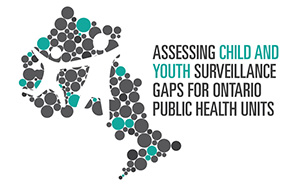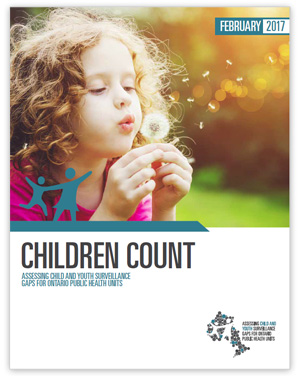
This locally driven collaborative project (LDCP) was funded by Public Health Ontario to study current practices, identify gaps, and explore novel approaches in regards to the collection, analysis, and reporting of local health status for school-age children and youth (Grade 1-12) in Ontario.
The findings of this year-long study were released in a final report titled Children Count as well as a summary report. The following is an overview of the key findings and recommendations from the final report.
Executive Summary
Supporting good health and positive well-being is fundamental to ensuring children and youth are able to reach their full potential. The need for high-quality health and well-being data is a shared priority across many sectors, and such data is required for targeting resources towards people with the greatest needs, for evaluating the impact of policies, and for planning and delivering equitable evidence-based services. Despite the need for data to drive evidence-informed decision making, there are considerable gaps and limitations related to Ontario’s ability to monitor child and youth health, primarily because the province lacks a sustainable and coordinated surveillance system.
To address this issue, the aim of this Locally Driven Collaborative Project (LDCP) was to determine current practices, identify gaps, and explore novel approaches in regards to the collection, analysis, and reporting of local health status for school-age children and youth (Grade 1-12) in Ontario.
The first phase (March-May 2016) of the project was an environmental scan survey of Ontario PHUs to: (i) determine challenges and barriers to assessing child and youth health status, and (ii) access to and usability of existing data sources for identifying local needs. In total, collaborative input was collected from 377 public health professionals from 34 of 36 Ontario PHUs (94% response rate).
Key findings from the environmental scan survey of Ontario PHUs:
- Most PHUs reported that insufficient data, barriers to accessing data, and analytical capacity gaps are challenges associated with child and youth health data.
- Mental health, healthy eating, growth and development, physical activity, and positive parenting were identified as the areas with the greatest need for more data.
- Data gaps and insufficient sample size for local estimates were compelling PHUs to actively collect their own data on children and youth; 84 examples of surveys were described.
- PHUs were generally aware of the existing data sources for child and youth health, but fewer were actually able to use these data sources to meet their needs for local assessment and surveillance.
- Moving forward, PHUs have requested that secondary data sources in general be improved by: having greater local sample sizes, filling in data gaps, better coordinating of efforts, enhancing accessibility, ensuring useful stratifying variables, and removing financial barriers.
- There was strong support for a coordinated surveillance system in Ontario, particularly if it will provide standardized data at the local PHU level. PHUs thought it ought to be headed by a provincial government body (e.g., ministry, resource centre, or affiliated organization).
- The second phase (June-October 2016) of this project sought a broader perspective on child and youth assessment and surveillance through interviews with key informants from relevant sectors in Ontario. Eleven interviews were completed with key informants from government (n=4), academia and research (n=3), and education (n=4), who were actively engaged in collecting, analyzing, and reporting on child and youth health data in Ontario. The interviews were coded thematically into five categories: needs, challenges and barriers, opportunities for improvement, current approaches, and emerging areas of interest.
Key findings from the interviews with key informants:
- There was a predominant need for high-quality data that could be used for multiple purposes including assessment and surveillance, program planning, evaluation, and decision-making.
- There was a commonly identified need for stronger partnerships and collaboration.
- Key informants identified systemic issues as a major challenge or barrier; particularly the lack of resources and disjointed surveillance efforts.
- Data and methodological limitations (mainly inadequate local sample sizes), survey fatigue among students, and challenges of collaborating effectively were the other dominant themes.
- The majority of key informants thought that expanding or augmenting existing assessment and surveillance efforts was the best opportunity for improvement. Most key informants identified room to improve collaborative work between all sectors. There were also opportunities to implement foundational changes to address systemic issues, particularly the cumbersome and inconsistent research ethics process in schools.
- Key informants identified a variety of techniques and approaches currently being used for assessment and surveillance of children and youth in Ontario. Sampling in school settings and collaboration were common components of many current approaches.
- Child and youth mental health was a common area of interest among nearly all key informants and across all sectors. Healthy eating and physical activity were other frequently identified areas of interest among key informants.
- This project took great effort to capture perspectives on the system of assessment and surveillance for child and youth health in Ontario from current system users and contributors. Through surveying and interviewing stakeholders from public health, education, academia, and government, the project team feels confident that the following recommendations are essential to improving the system of assessment and surveillance to be more responsive at the local, regional and provincial level.
Recommendations
- Establish a Provincial Task Force: Establish a provincial task force, with membership representing key stakeholders, which will aim to identify next steps for improving assessment and surveillance of child and youth health and well-being in Ontario.
- Recruit leadership representatives from government, public health, education, and academia to form a provincial task force. This includes, but is not limited to, representatives from public health units, Public Health Ontario, school boards, university and research institutions, the Ontario Ministry of Education, the Ontario Ministry of Health and Long-Term Care, and relevant resource centres. These representatives will meet regularly.
- The task force should produce a briefing with recommended next steps for improving the assessment and surveillance of the health and well-being of Ontario children and youth.
- Experts and stakeholders should be consulted when necessary, and the task force should build on the work of this report and previous work, as well as coordinate with other current initiatives related to assessment and surveillance of children and youth.
- The task force should provide guidance and oversight for the implementation of its recommendations and the recommendations of the present report.
- Advocate for Children and Youth: Raise awareness among decision makers about the importance of quality data on children and youth, and the opportunities for improving assessment and surveillance of this population.
- The Population Health Assessment LDCP team should actively and regularly engage in knowledge exchange activities with relevant decision-makers, including the dissemination of project deliverables and updates on next steps.
- The Province of Ontario, which includes the Ministries of Education and Health and Long-Term Care, should develop a shared mandate that will drive changes in the assessment and surveillance of child and youth health.
- Ontario public health units and school boards should collaboratively advocate the needs of their child and youth populations to their respective decision-makers.
- The Ontario government and relevant ministries should support assessment and surveillance province-wide so that all child and youth populations are included irrespective of locality.
- Support Multi-sectoral Collaboration: Promote meaningful, multi-sectoral partnerships and collaborations that foster effective and efficient assessment and surveillance of children and youth.
- The Ontario education system should move towards a more consistent and simplified research process that allows for better collaboration with government and academic researchers and lessons the burden on local boards of education.
- Explore implementing a student health and well-being surveillance system within the Ontario education system that is standardized and universal for all Ontario schools in collaboration with public health and academia. School boards should also be allowed to complement such a universal system with individualized assessment efforts.
- Improve communication and feedback mechanisms between academic institutions, school boards, and public health units, such that there is open sharing of data and results across sectors.
- Strengthen and Coordinate Existing Surveillance Systems: Invest in enhancing and expanding existing approaches to meet the needs of identified stakeholders in Ontario.
- Increase the awareness of existing child and youth data sources in Ontario, including the strengths and limitations of these sources, among different sectors and stakeholders.
- Prioritize the collection of data for mental health, healthy eating, and physical activity among children and youth in Ontario.
- Increase the number of children and youth surveyed to allow for useful and reliable estimates at the local level.
- Create mechanisms to foster better response rates, including the use of passive consent.
- Ensure that health and well-being data is linked to other variables including age, sex and gender, household income, postal code, and parental education.
- Standardize metrics across surveillance systems so that data can be compared across regions and within regions.
- Support systems that incorporate direct measures where appropriate and possible.
Stakeholders from local public health, academia, education, and other government agencies described many challenges and gaps related to the assessment and surveillance of child and youth health in Ontario. The current approach as experienced by these stakeholders is seen as inefficient. Individual efforts to address health data gaps drain limited financial and human resources and leads to duplication. Capacity at PHUs, schools, and other institutions is limited by locality and availability of resources, resulting in inequity in the system of surveillance and assessment for children and youth. The primary root cause of these issues is the lack of a dedicated data source for children and youth that is representative and reportable at the local level. Unlike other Canadian provinces and developed countries, Ontario lacks an integrated, sustainable, and coordinated surveillance system to monitor child and youth health. Investing in such a system would enhance the impact of our healthcare dollars, provide evidence to inform decision makers about planning of health services, reduce inefficiencies across sectors, increase accountability, and, most importantly, it would be an invaluable asset to the health and well-being of children and youth in Ontario.


